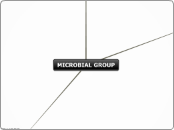MICROBIAL GROUP
EUKARYOTES
FUNGI
ECOLOGICAL ROLE
FUNGI AS FOOD
FUNGI AS PATHOGENS
causes ringworm,carcinogens,aflatoxin
HELP IN IMPROVE GROWTH
Mycorrhizae
FUNGI AS SPOILER
Decompose food, wood and etc.
FUNGI AS DECOMPOSER
Reduce complex polysaccharides and proteins into simple organic compounds and use by other
Recycling carbon, nitrogen and other elements to the ecosystem
FUNGI TO MODIFY HABITAT
Lichens inhabit inhospitable places and make
habitat suitable for life
TYPE OF FUNGI
Basidiomycetes-club
Chytridimycota-chytrid
Zycomycota-zygote
Ascomycetes-sac
CHARACTERISTICS
no cholorophyll
cell wall-chitin
nutrient stored-glycogen
spores bearer
multicellular except yeast
MOLDS
ECOLOGICAL ROLE
Moist terrestrial habitats e.g. soil, decaying
wood, dung and etc.
Engulf bacteria (as predator)
As decomposer and consumer in the ecosystem
Cause diseases in plants e.g. tobacco plants,
potatoes, grapes
TYPE OF MOLD
Myxomycota (Plasmodial slime molds)
Characteristics
viscous masses of slime
saprophytes
motile amoeboid mass called plasmodium
(lack of cell wall)
phagocytosized dead material
Acrasiomycota (Cellular slime molds)
Characteristics
cellular slime molds
individual amoeboid cells
(unicellular)
- feed phagocytically
Oomycota (Water molds)
Characteristics
Sexual reproduction:
Oogonium fertilized by sperm cell/
antheridium to zygote to germinates to
asexual zoospores with flagella
ALGAE
CHARACTERISTICS
Simple “aquatic plants”
Eucaryotic + chlorophyll and pigments
Differences with other photosynthetic
eucaryotes
Photoautotrophic
DISTRIBUTION
PRIMARILY AQUATIC
Planktonic
Benthic
Neustonic
ECOLOGICAL ROLE
provide habitat for marine communities
as human food or to make various
products
Human food e.g. sushi
food base for marine food chains
-Phytoplankton convert CO2 into
protoplasm -->consumed by zooplankton --> crustaceans --> fishes --> humans
Algal bloom
Disrupt higher links of local food web
Production of neurotoxin by algae
PROTOZOA
CHARACTERISTICS
Motile eucaryotic unicellular protist
Eucaryotic cells but unicellular
Distribution: moist habitat, mostly
free living in freshwater or marine,
some terrestrial (soil)
TYPE OF PROTOZOA
Sarcomastigophora
Flagellates and
amoebae; single type
of nucleus
-Labyrinthomorpha
-Apicomplexa
-Microspora
-Ascetospora
-Myxozoa
Saprozoic or
parasitic sp.
Ciliophora
Ciliated and 2
types of nuclei
ECOLOGICAL ROLE
In the marine food chain
- Zooplankton (protozoans) ingest
phytoplankton and bacteria
- Influence the C and N cycle in
oceans
- A link for primary production and
higher levels in the food chain.
Parasitic relationship (cause harm to host)
- Zooflagellate Trypanosoma (African Sleeping Sickness in humans)
- Sporozoans: Plasmodium causes Malaria
Mutualistic relationship (both organisms
benefit) e.g. with ruminants
- Degradation of fibrous plant materials
releasing energy and VFA for growth of animals
- Major barrier to the passage of
pathogens through the digestive tract of
ruminants
PROKARYOTES
BACTERIA
ECOLOGICAL ROLE
To remove detrimental pollutants from
the environment
Recycling of chemical components
Symbiotic relationships
- Interactions: commensalism, parasitism,
mutualism
- e.g. N fixing bacteria provide source of N
for plants
- e.g. Cause various kinds of diseases e.g.
tuberculosis, pneumonia, cholera
Bioremediation
CHARACTERISTICS
Various morphology
Cellular organization: DNA not enclosed in
membrane, no other membrane bound
compartments, genome 1/1000 smaller than
eucaryotic genome
Reproduction: Binary fission.
Shorter generation time
quick evolution
higher mutation rate
Photoautotrophs
Chemotrophs
Autotrophs
Heterotrophs
VIRUSES
CHARACTERISTICS
obligate intracellular parasites
cannot replicate outside living cell
DIFFERENCES BETWEEN VIRUS AND OTHER
a. Presence of either DNA or RNA
b. Inability to reproduce independent of cells
c. Inability to carry out cell division as procaryotes
and eucaryotes
ECOLOGICAL ROLE
Mostly disease causing in human,
animals and plants
Biological warfare
